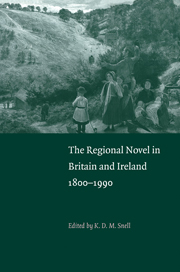Book contents
- Frontmatter
- Contents
- Preface and acknowledgements
- 1 The regional novel: themes for interdisciplinary research
- 2 Regionalism and nationalism: Maria Edgeworth, Walter Scott and the definition of Britishness
- 3 The deep romance of Manchester: Gaskell's ‘Mary Barton’
- 4 Geographies of Hardy's Wessex
- 5 Gender and Cornwall: Charles Kingsley to Daphne du Maurier
- 6 James Joyce and mythic realism
- 7 Cookson, Chaplin and Common: three northern writers in 1951
- 8 Emyr Humphreys: regional novelist?
- 9 Scotland and the regional novel
- 10 Mapping the modern city: Alan Sillitoe's Nottingham novels
- Index
10 - Mapping the modern city: Alan Sillitoe's Nottingham novels
Published online by Cambridge University Press: 18 December 2009
- Frontmatter
- Contents
- Preface and acknowledgements
- 1 The regional novel: themes for interdisciplinary research
- 2 Regionalism and nationalism: Maria Edgeworth, Walter Scott and the definition of Britishness
- 3 The deep romance of Manchester: Gaskell's ‘Mary Barton’
- 4 Geographies of Hardy's Wessex
- 5 Gender and Cornwall: Charles Kingsley to Daphne du Maurier
- 6 James Joyce and mythic realism
- 7 Cookson, Chaplin and Common: three northern writers in 1951
- 8 Emyr Humphreys: regional novelist?
- 9 Scotland and the regional novel
- 10 Mapping the modern city: Alan Sillitoe's Nottingham novels
- Index
Summary
As a literary form, the novel is inherently geographical. The world of the novel is made up of locations and settings, arenas and boundaries, perspectives and horizons. Various places and spaces are occupied or envisaged by the novel's characters, by the narrator and by audiences as they read. Any one novel may present a field of different, sometimes competing, forms of geographical knowledge and experience, from a sensuous awareness of place to an educated idea of region and nation. These various geographies are coordinated by various kinds of temporal knowledge and experience, from circumscribed routines to linear notions of progress or transformation.
From its formulation in the eighteenth century, the novel has been a speculative instrument for exploring and articulating those material, social and mental transformations we call modernisation. The novel was first associated with the transformation of London into a world metropolis, representing the capitalist city to its bourgeois citizens as ‘accessible, comprehensible and controllable’. Its scope was not confined to the city; early novelists charted transformations in the countryside and colonies too. The refinement of the novel as a genre was commensurate with the refinement of a number of geographical discourses, such as town planning, estate improvement, cartography and topographical painting, which surveyed and re-ordered the spaces of the modernising world. From the time of Defoe, the novel has been fashioned and refashioned as an instrument for representing various geographies in different phases, forms and sites of modernisation.
- Type
- Chapter
- Information
- The Regional Novel in Britain and Ireland1800–1990, pp. 257 - 289Publisher: Cambridge University PressPrint publication year: 1998
- 2
- Cited by



